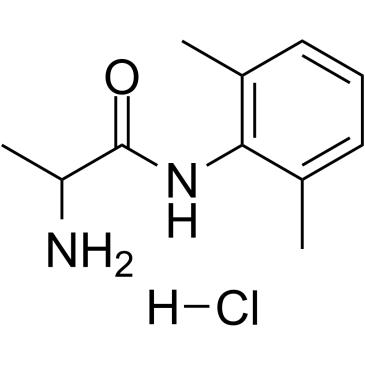Tocainide hydrochloride

Tocainide hydrochloride structure
|
Common Name | Tocainide hydrochloride | ||
|---|---|---|---|---|
| CAS Number | 71395-14-7 | Molecular Weight | 192.25800 | |
| Density | N/A | Boiling Point | N/A | |
| Molecular Formula | C11H17ClN2O | Melting Point | N/A | |
| MSDS | Chinese USA | Flash Point | N/A | |
| Symbol |

GHS07 |
Signal Word | Warning | |
Use of Tocainide hydrochlorideTocainide hydrochloride is a sodium channel blocker, it blocks the sodium channels in the pain-producing foci in the nerve membranes. Tocainide hydrochloride is a primary amine analog of lidocaine, can be used for the treatment of tinnitus[1][2]. |
| Name | tocainide |
|---|---|
| Synonym | More Synonyms |
| Description | Tocainide hydrochloride is a sodium channel blocker, it blocks the sodium channels in the pain-producing foci in the nerve membranes. Tocainide hydrochloride is a primary amine analog of lidocaine, can be used for the treatment of tinnitus[1][2]. |
|---|---|
| Related Catalog | |
| Target |
IC50: sodium channel[1] |
| In Vivo | Tocainide (100 mg/kg) effectively suppresses ventricular ectopic activity in unanesthetized dogs with coronary occlusion. Termination of tocainide infusion in both digitalis toxicity and coronary occlusion models results in prompt return of ventricular ectopic activity[1]. |
| References |
| Molecular Formula | C11H17ClN2O |
|---|---|
| Molecular Weight | 192.25800 |
| Exact Mass | 192.12600 |
| PSA | 55.12000 |
| LogP | 2.36240 |
| InChIKey | AMZACPWEJDQXGW-UHFFFAOYSA-N |
| SMILES | Cc1cccc(C)c1NC(=O)C(C)N.Cl |
| Symbol |

GHS07 |
|---|---|
| Signal Word | Warning |
| Hazard Statements | H302 |
| Precautionary Statements | P301 + P312 + P330 |
| Personal Protective Equipment | dust mask type N95 (US);Eyeshields;Gloves |
| Hazard Codes | Xi |
| RIDADR | UN1230 - class 3 - PG 2 - Methanol, solution |
|
Synthesis, structure and pharmacology of acyl-2,6-xylidines.
Acta Pol. Pharm. 61(3) , 215-21, (2004) L-2-perhydroheterocyclicalkyl acids were condensed with 2,6-xylidine. 8 new optically active acyl-2,6-xylidines were obtained. Absolute configuration of acyl-2,6-xylidines were selected for pharmacolo... |
|
|
Quantitative structure-pharmacokinetic relationships for drug clearance by using statistical learning methods.
J. Mol. Graph. Model. 24(5) , 383-95, (2006) Quantitative structure-pharmacokinetic relationships (QSPkR) have increasingly been used for the prediction of the pharmacokinetic properties of drug leads. Several QSPkR models have been developed to... |
|
|
The efficacy of anticonvulsants on orofacial pain: a systematic review.
Oral Surg. Oral Med. Oral Pathol. Oral Radiol. Endod. 111(5) , 627-33, (2011) Controversy exists about the effectiveness of anticonvulsants for the management of orofacial pain disorders. To ascertain appropriate therapies, a systematic review was conducted of existing randomiz... |
| (+-)-2-amino-N-(2,6-dimethylphenyl)propionamide hydrochloride |
| 4-Amino-2-[4,6-diamino-3-[3-amino-6-(aminomethyl)-5-hydroxyoxan-2-yl]oxy-2-hydroxycyclohexyl]oxy-6-(hydroxymethyl)oxane-3,5-diol sulfate |
| Tobramycin sulfate [usan] |
| Tocainidhydrochlorid |
| 6'-propionoxylidide hydrochloride |
| TOBRAMYCIN SULPHATE |